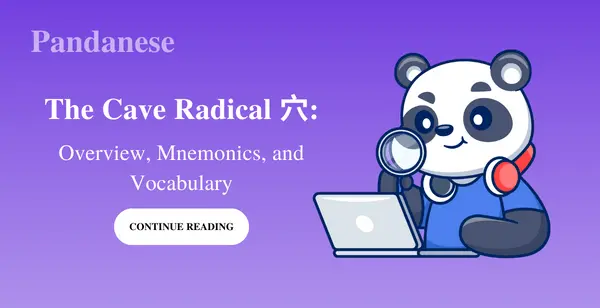
The Cave Radical 穴: Overview, Mnemonics, and Vocabulary
Without any further ado, let’s scroll down to get interesting information about the cave radical and, as always, a fun mnemonic to help you remember this radical for a long time!
What is the cave radical?

The cave radical 穴, which is pronounced as “xué” in Mandarin Chinese, is also known as radical 116 according to the Kangxi radical chart (a system of radicals of Chinese characters). Also, according to the Kangxi dictionary, 298 characters (out of 49,030) contain the radical cave 穴.
What is the stroke order of the cave radical?
The cave radical has five strokes, written in the following order:

How can you memorize the cave radical?
We came up with a simple Chinese mnemonic for you to use: This radical means a cave. It looks like an entrance with a roof (宀). A group of mountain climbers survived a storm by taking shelter in a cave.
If you want more mnemonics to help you learn Chinese characters and their meanings, try Pandanese! They employ mnemonics with SRS to have you effectively learn and review Chinese radicals, characters, and vocabulary when you need it. Learning Chinese couldn’t be any easier!
A cave radical vocabulary list for you!
Thrilled to know more about the cave radical and other related terms? Pandanese is here to help you enrich your knowledge.
Character |
Pinyin |
English meaning |
洞穴 |
dòngxué |
cavern |
岩穴 |
yánxué |
grotto |
阴穴 |
yīn xué |
underground cave |
兽穴 |
shòu xué |
animal den |
穴居人 |
xuéjū rén |
caveman |
空 |
kōng |
to empty |
究 |
jiū |
to study or investigate |
穷 |
qióng |
exhausted |
穿 |
chuān |
to dress |
Cave radical vocabulary list
In closing
Learning the Chinese cave radical will give you insights into complex Chinese characters that use this radical. The meaning usually relates to underground spaces, emptiness, exploration, and even exhaustion.
Keep you with your Chinese radical study!
The easiest way to learn Chinese & build vocabulary

